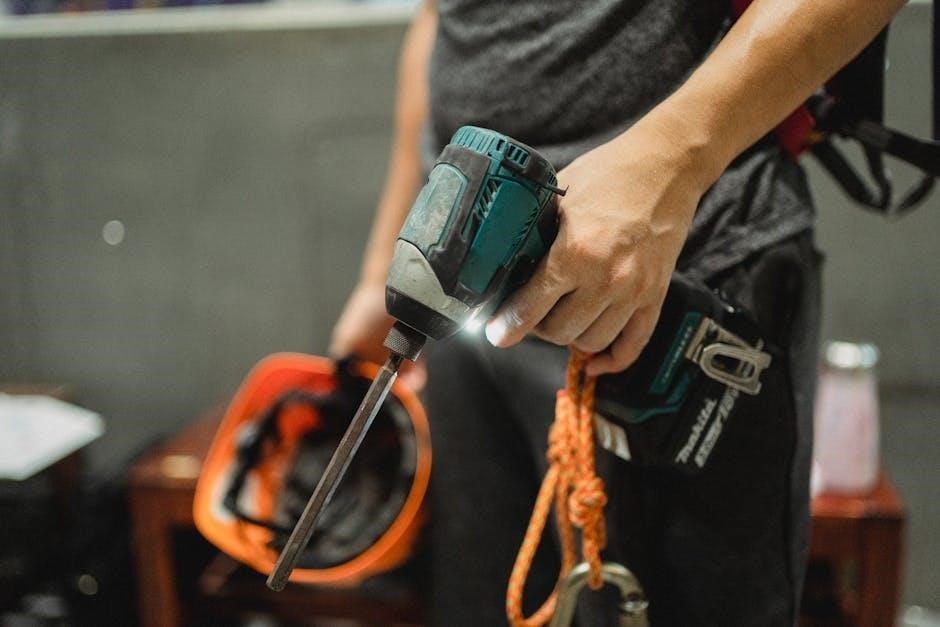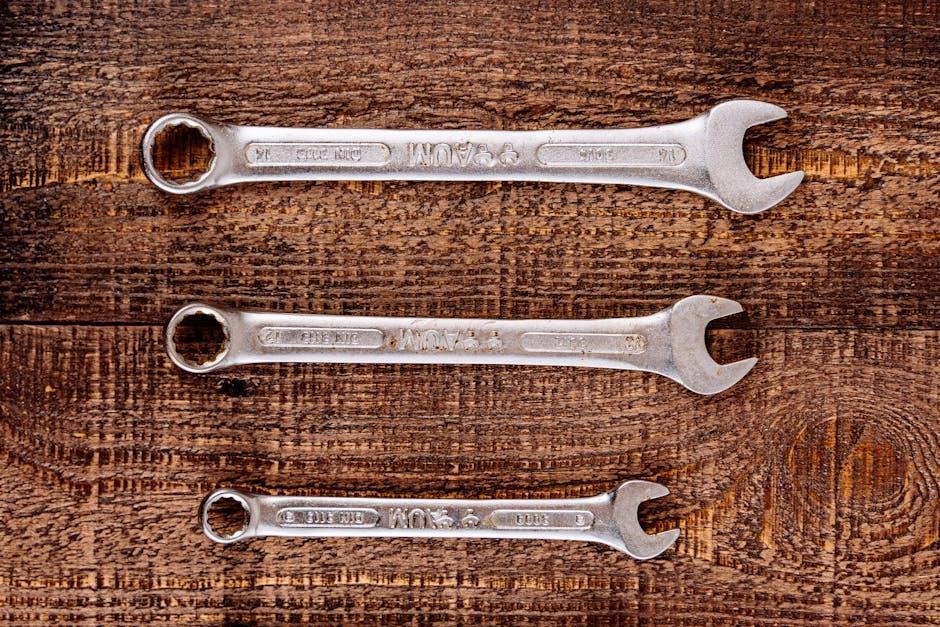Harley service manuals are essential for maintaining and repairing your motorcycle, offering detailed instructions, diagrams, and specifications. Available in PDF, they ensure accurate DIY repairs and maintenance for optimal performance and safety.
1.1 Overview of Harley-Davidson Service Manuals
Harley-Davidson service manuals provide comprehensive guidance for maintaining, troubleshooting, and repairing motorcycles. Available in PDF format, these manuals cover various models, ensuring riders and mechanics have precise instructions. They include detailed diagrams, torque specifications, and step-by-step procedures for both basic maintenance and complex repairs. Whether addressing engine issues, electrical systems, or brake components, the manuals are tailored to promote safety and efficiency. By following these guides, users can ensure their bikes perform optimally while adhering to factory standards. The manuals also emphasize the importance of using genuine Harley-Davidson parts for reliability and durability, making them indispensable for enthusiasts and professionals alike.
1.2 Importance of Using Official Service Manuals
Official Harley-Davidson service manuals are crucial for ensuring accurate and safe repairs. They provide precise instructions, specifications, and diagrams tailored to specific models, reducing the risk of errors. Using official manuals helps maintain the bike’s performance, reliability, and warranty compliance. They are essential for both DIY enthusiasts and professional mechanics, offering a comprehensive guide for troubleshooting and maintenance. By following these manuals, riders can avoid costly mistakes and ensure their motorcycle operates at peak condition. Official manuals are a vital resource for anyone looking to keep their Harley-Davidson in pristine shape and maintain its resale value over time.

Structure of a Harley Service Manual
A Harley service manual is organized into clear sections, including a table of contents, technical specifications, and detailed procedures. It provides a logical flow for easy navigation.
2.1 Table of Contents and Organization
The table of contents in a Harley service manual is meticulously organized, ensuring easy access to information. It typically includes sections such as maintenance schedules, troubleshooting guides, and repair procedures. Each chapter is clearly labeled, allowing users to quickly locate specific topics. The manual is structured to cater to both novice and experienced riders, providing a logical flow of information. This organization ensures that users can efficiently navigate through the manual, making DIY repairs and maintenance more manageable. The clear categorization also helps in reducing the time spent searching for relevant instructions, enhancing the overall user experience.
2.2 Key Sections Every Rider Should Know
Every rider should familiarize themselves with key sections of the Harley service manual, including maintenance schedules, troubleshooting guides, and detailed repair procedures. The manual highlights essential tasks like oil changes, tire pressure checks, and brake inspections. Additionally, it covers critical systems such as the engine, transmission, and electrical components. Understanding these sections ensures riders can perform routine maintenance and address common issues effectively. The manual also provides torque specifications, fluid capacities, and wiring diagrams, which are vital for accurate repairs. These sections empower riders to keep their bikes in optimal condition and handle repairs with confidence.

2.3 How to Navigate the Manual Effectively
To navigate the Harley service manual effectively, start by reviewing the table of contents to locate specific sections quickly. Use the index for keyword searches to find detailed procedures or diagrams. For digital versions, utilize the search function to pinpoint information rapidly. Familiarize yourself with symbols and abbreviations used throughout the manual for clarity. Prioritize sections like maintenance schedules and troubleshooting guides, as they are essential for regular upkeep. By organizing your approach and referencing visual aids like diagrams and charts, you can efficiently locate and apply the information needed to service your Harley-Davidson motorcycle.

Maintenance Schedules and Routine Service
Regular maintenance is crucial for optimal performance. Follow the recommended schedules for oil changes, tire inspections, and brake checks to ensure reliability and prevent potential issues.
3.1 Recommended Maintenance Intervals
Harley-Davidson service manuals outline specific maintenance intervals to ensure your motorcycle runs smoothly. Regular oil changes are recommended every 5,000 miles, while the primary chain and drive belt should be inspected and serviced every 10,000 miles. Brake pads and rotors need attention every 15,000 miles, and the air filter should be replaced every 20,000 miles. Spark plugs typically require replacement every 30,000 miles. Adhering to these intervals prevents wear and tear, enhances fuel efficiency, and ensures reliability. Always consult the manual for precise schedules tailored to your model and riding conditions to maintain optimal performance and longevity.
3.2 Essential Tools and Equipment Needed
Proper tools and equipment are crucial for effective motorcycle maintenance. Basic tools include wrenches, screwdrivers, pliers, and socket sets. Specialized tools like a torque wrench, tire pressure gauge, and oil filter wrench are essential for specific tasks. Safety gear such as gloves, safety glasses, and a well-ventilated workspace are also necessary. A hydraulic lift or jack can simplify tasks like tire changes or engine access. Always refer to the service manual for model-specific tool recommendations to ensure accuracy and safety during repairs and maintenance. Having the right tools ensures efficiency and prevents damage to your Harley-Davidson motorcycle.
3.3 Common Maintenance Mistakes to Avoid
Common maintenance mistakes include neglecting regular oil changes, failing to check tire pressure, and improper tightening of bolts. Overlooking brake pad inspections can lead to unsafe riding conditions. Using incorrect fluids or lubricants can damage engine components. Forgetting to torque specifications can result in loose connections or stripped threads. Skipping routine inspections for worn-out parts, such as spark plugs or air filters, can reduce performance. Always follow the service manual’s guidelines to avoid these pitfalls and ensure your Harley-Davidson runs smoothly and safely. Proper maintenance habits are key to extending the life of your motorcycle.

Troubleshooting Common Issues
Harley service manuals guide troubleshooting common issues like engine problems, electrical faults, and brake system failures. They provide diagnostic steps and solutions, ensuring effective repairs and safety.
4.1 Diagnosing Engine Problems
Diagnosing engine issues in your Harley-Davidson starts with identifying symptoms like unusual noises, reduced performance, or warning lights. The service manual provides detailed troubleshooting charts and diagnostic procedures to pinpoint problems. From compression tests to ignition system checks, the manual guides you through step-by-step inspections. By following the recommendations, you can determine if issues stem from fuel delivery, spark plugs, or internal components. Early detection and repair prevent costly damage, ensuring your engine runs smoothly and efficiently. Regular maintenance, as outlined, further helps avoid major breakdowns, keeping your Harley in peak condition.
4.2 Electrical System Troubleshooting
Troubleshooting the electrical system of your Harley-Davidson begins with identifying symptoms like faulty lights, dead batteries, or malfunctioning accessories. The service manual provides detailed diagrams and step-by-step guides to locate issues. Start by checking fuses and circuit breakers, then test wiring and connections for damage or corrosion. Use a multimeter to measure voltage and resistance, ensuring proper electrical flow. The manual also covers testing ignition switches, starters, and sensors. By following these procedures, you can diagnose and repair electrical faults efficiently, restoring your bike’s functionality and safety. Regular checks prevent recurring issues, keeping your Harley’s electrical system in top shape.
4.3 Brake System Maintenance and Repair
Maintaining your Harley’s brake system is critical for safety. The service manual outlines procedures for inspecting brake pads, rotors, and fluid levels. Replace worn pads when thickness falls below 1/8 inch. Check rotors for excessive wear or warping and replace if necessary. Bleed the brake system to remove air bubbles, ensuring proper fluid flow. Adjust brake levers and pedals to maintain optimal performance. Regularly cleaning and lubricating brake components prevents corrosion and ensures smooth operation. Follow the manual’s guidelines for torque specifications and safety precautions to guarantee reliable braking and rider safety on the road.

Detailed Repair and Replacement Guides
Harley service manuals provide step-by-step instructions for complex repairs, including engine overhauls and brake system replacements. Follow detailed diagrams and torque specifications for safe, precise work.
5.1 Step-by-Step Engine Repair Instructions
Harley service manuals offer comprehensive, step-by-step guides for engine repairs, ensuring accurate disassembly and reassembly. Detailed instructions cover cylinder head replacement, piston installation, and timing chain adjustments. Clear diagrams and torque specifications are provided to prevent damage and ensure reliability. Whether addressing oil leaks or performance issues, these manuals empower riders to tackle complex tasks with confidence. Proper tools and safety precautions are emphasized, making DIY engine repairs accessible for enthusiasts of all skill levels while maintaining manufacturer standards for optimal performance and longevity.
5.2 Replacing Brake Pads and Rotors
Harley service manuals provide detailed guidance for replacing brake pads and rotors, ensuring rider safety and optimal braking performance. Instructions outline proper tools, safety precautions, and step-by-step procedures. Riders are advised to inspect pads for wear and rotors for warping. The manual specifies torque values for caliper bolts and rotor installation. Clear diagrams illustrate pad replacement and rotor alignment. Testing brakes after installation is emphasized to ensure functionality. Following these guidelines helps maintain reliable braking systems, critical for motorcycle safety and control. This section is vital for DIY enthusiasts seeking to perform precise and effective brake maintenance.

5.3 Upgrading or Replacing Tires
Harley service manuals guide riders through tire upgrades or replacements, ensuring safety and performance. The process begins with selecting tires compatible with the motorcycle’s make and model, as specified in the manual. Proper tools and safety precautions are highlighted to avoid wheel damage. Step-by-step instructions cover removal of old tires, inspection of wheels, and installation of new ones. Balancing tires is emphasized to prevent vibration and ensure smooth riding. The manual also provides torque specifications for wheel bolts and recommendations for testing the brakes after tire replacement. Following these steps ensures optimal handling and safety on the road.

Customization and Performance Upgrades
Enhance your Harley’s performance, style, and handling with aftermarket parts and mods. Follow manual guidelines for installing upgrades, ensuring compatibility and optimal results for your ride.
6.1 aftermarket Parts Compatibility
6.1 Aftermarket Parts Compatibility
Ensuring aftermarket parts compatibility is crucial for maintaining your Harley’s performance and warranty. Always consult the official service manual to verify specifications and guidelines. Check electrical systems, engine compatibility, and fitment before installation. Incorrect parts can lead to system malfunctions or void warranties. Use trusted manufacturers and follow manual recommendations for optimal results. Proper installation ensures safety, reliability, and enhances your bike’s overall performance and style. Always prioritize compatibility to maintain your Harley’s integrity and avoid potential issues down the road.
6;2 Installation Guides for Performance Mods
Installation guides for performance mods in your Harley service manual provide step-by-step instructions for upgrading components like exhaust systems, air filters, and engine tuners. These guides include torque specifications, wiring diagrams, and compatibility checks to ensure seamless integration. Always use factory-recommended tools and follow safety precautions to avoid damage or injury. Proper installation enhances performance, fuel efficiency, and ride quality. For complex mods, consider consulting a professional. Adhering to the manual ensures your bike operates at peak levels while maintaining warranty compliance and safety standards. This section is vital for riders seeking to customize their Harley for optimal power and style.
6.3 Tuning and Adjustments for Optimal Performance
Tuning and adjustments are critical for maximizing your Harley’s performance. The service manual provides detailed procedures for fine-tuning components like carburetors, fuel injectors, and ignition systems. Proper adjustments ensure smooth operation, improved fuel efficiency, and enhanced power delivery. Diagnostic procedures help identify issues, while test rides validate adjustments. Always use calibrated tools and follow specified torque values. Regular tuning prevents mechanical wear and maintains optimal engine performance. Adhering to the manual’s guidelines ensures your bike runs smoothly, delivering the legendary Harley experience. Proper tuning is essential for reliability and peak performance, whether cruising or pushing limits.

Safety Precautions and Best Practices
Always wear protective gear, ensure a stable workspace, and use proper tools when servicing your Harley. Follow manual guidelines to avoid injuries and ensure safe repairs.
7.1 Essential Safety Gear for Working on Your Bike
When working on your Harley, essential safety gear includes gloves, safety glasses, and steel-toe boots to protect against injuries. A face mask is recommended when grinding or sanding to avoid inhaling dust. Proper insulation and grounding tools prevent electrical shocks. Ensure your workspace is well-lit and free from flammable materials. Always wear a full-face helmet and leather jacket for added protection. Keep a fire extinguisher nearby and avoid loose clothing that could get caught in moving parts. Proper safety gear and precautions minimize risks, ensuring a safe and successful repair experience.
7.2 Proper Workshop Setup and organization
7.2 Proper Workshop Setup and Organization
A well-organized workshop is crucial for efficient and safe bike maintenance. Use a sturdy workbench with a vice and tool organizers to keep tools within easy reach. Store tools in labeled compartments to reduce clutter and save time. Ensure good lighting, preferably with LED lamps, to illuminate your work area. Keep a small parts organizer for screws and bolts. A clean, organized workspace prevents misplaced parts and reduces the risk of errors. Regularly inspect and maintain your tools to ensure they are in good condition. A structured workspace enhances productivity and safety while working on your Harley.
7.3 Environmental Considerations for Repairs
Proper disposal of hazardous materials like oil, coolant, and batteries is crucial to protect the environment. Use eco-friendly cleaning products and recycle metal parts when possible. Dispose of tires responsibly through authorized centers. Energy-efficient tools and lighting can reduce your carbon footprint. Store chemicals in sealed containers to prevent spills. Regularly inspect your workspace for potential environmental hazards and address them promptly. Following these guidelines ensures your Harley repairs are both effective and environmentally responsible, promoting sustainability in your workshop practices.

Resources and Support
Harley-Davidson offers extensive resources, including official support channels, online forums, and local dealerships, providing expert advice, DIY guides, and troubleshooting tips to keep your bike in peak condition.
8.1 Official Harley-Davidson Support Channels
Harley-Davidson provides comprehensive support through official channels, ensuring riders have access to expert guidance and resources. The official website offers detailed service manuals, troubleshooting guides, and maintenance schedules. Additionally, authorized dealerships employ trained professionals who can address specific queries and perform complex repairs. Owners can also utilize the Harley-Davidson online portal for parts lookup, diagnostic tools, and repair tutorials. These resources are designed to complement the service manual, offering a holistic approach to bike care. Whether you’re a seasoned mechanic or a DIY enthusiast, official support ensures your Harley runs at peak performance.
8.2 Online Communities and Forums
Online communities and forums dedicated to Harley-Davidson enthusiasts provide invaluable resources and support. Platforms like the 1st Moscow Chapter and global H.O.G. forums offer spaces to discuss repairs, share tips, and access user-generated guides. Websites such as Cycle Trader and Harley-Davidson forums feature threads on troubleshooting and maintenance, often referencing service manuals. These communities foster collaboration, allowing riders to learn from experienced owners and mechanics. They also serve as hubs for sharing PDF manuals and DIY tutorials, making them indispensable for riders seeking practical advice and real-world insights.
8.3 Local Dealerships and Service Centers
Local Harley-Davidson dealerships and service centers are primary resources for riders, offering expert advice, genuine parts, and comprehensive support. Dealers like Orange County Harley-Davidson and Moscow Harley-Davidson provide access to official service manuals, ensuring accurate repairs and maintenance. Their knowledgeable staff assists with troubleshooting and offers guidance tailored to specific models. Additionally, these centers host workshops and events, fostering a community of riders who share tips and experiences. By visiting a local dealership, riders can ensure their bikes are serviced to factory standards, maintaining performance, safety, and warranty compliance. These centers are indispensable for riders seeking professional care and reliable resources.
Harley service manuals empower riders with knowledge, ensuring optimal bike performance and safety. Regular maintenance and proper repairs extend the life of your motorcycle, delivering lasting satisfaction.
9.1 Final Tips for Using Your Harley Service Manual
Always refer to your Harley service manual before starting any repair or maintenance task. Ensure you have the correct tools and follow torque specifications precisely for safety and performance. Regularly update your manual with the latest revisions and supplements for accuracy. When in doubt, consult official Harley-Davidson support or experienced mechanics. Keep the manual clean and organized for easy reference. Finally, use the troubleshooting guides to identify and resolve issues efficiently. By following these tips, you’ll maximize your manual’s benefits and keep your bike in top condition for years to come;
9.2 Encouragement to Keep Your Bike in Top Condition
Regular maintenance is key to ensuring your Harley-Davidson performs optimally and retains its value. By following the service manual’s guidelines, you can identify potential issues early, preventing costly repairs. Proper care not only enhances safety but also boosts your riding experience. Take pride in your bike’s condition, as it reflects your dedication to its longevity. Make maintenance a habit, and your Harley will reward you with years of reliability and unforgettable adventures on the road. Keep your bike in top shape, and it will continue to deliver the freedom and joy that only a Harley can provide.



